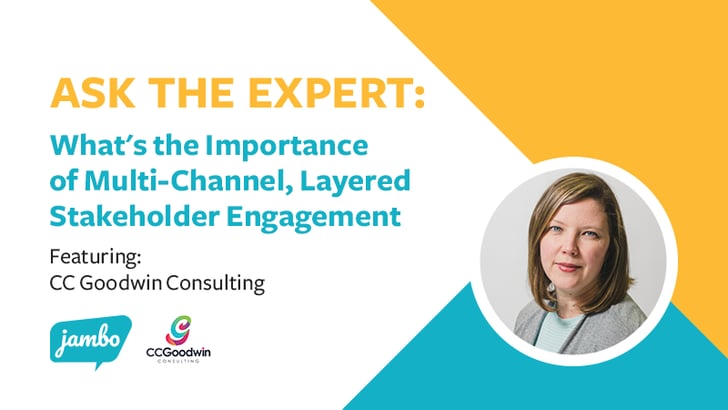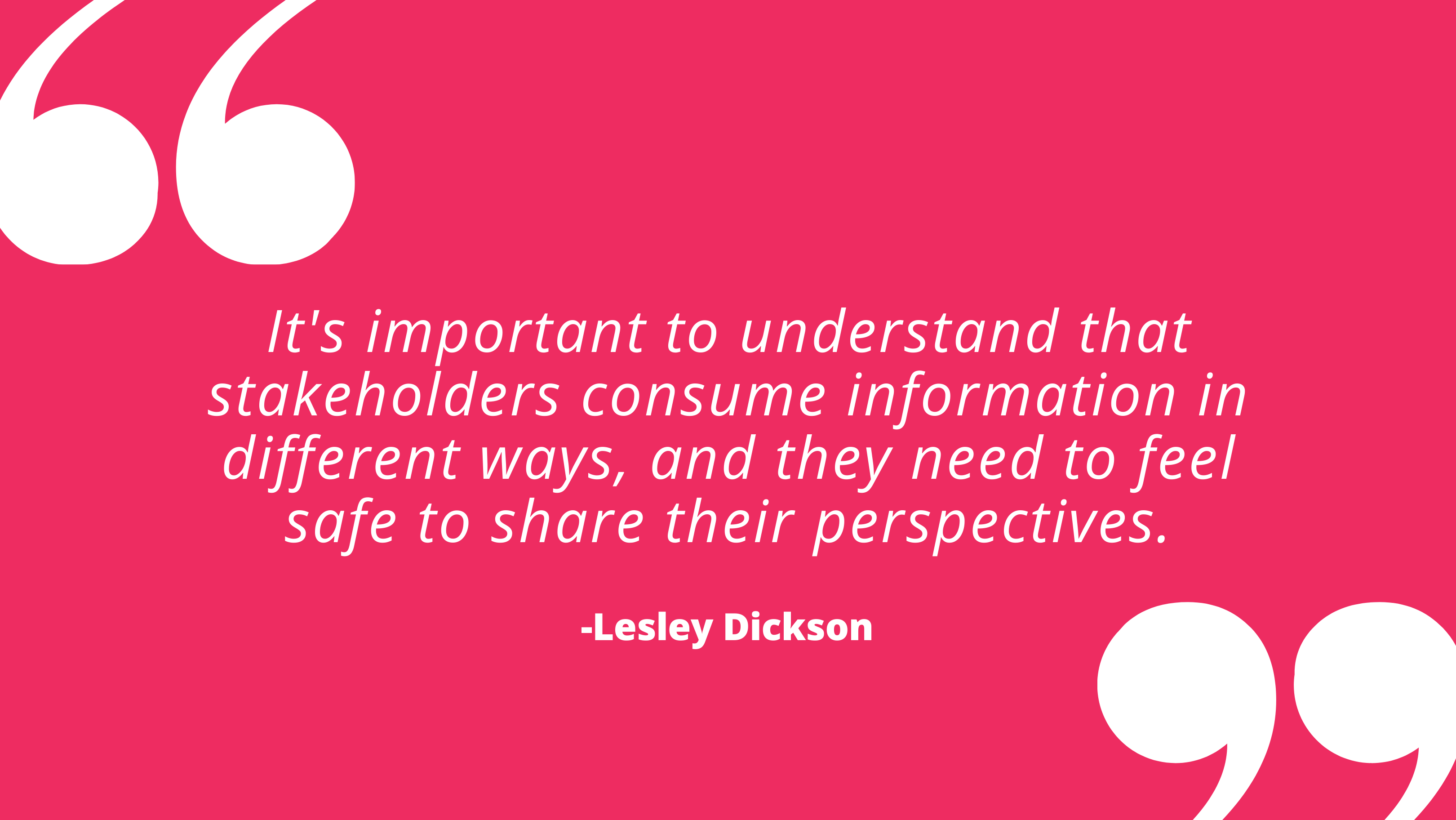
¿Qué es la participación multicanal y por capas de las partes interesadas y por qué es importante, especialmente en los tiempos de recuperación de Covid-19?
Hoy se une a Jambo para este blog de preguntas y respuestas Lesley Dickson, de CC Goodwin Consulting (CCG). Para conocer la biografía de Lesley y del equipo de CCG, visite el sitio web de CC Goodwin Consulting.
Hoy hablamos con Lesley sobre la importancia de la participación multicanal y por capas de las partes interesadas.
P: Lesley, háblame de ti y de tu papel en CC Goodwin Consulting.
En CC Goodwin Consulting, soy Responsable de Práctica, Comunicaciones, lo que significa que superviso y gestiono los proyectos de nuestra empresa relacionados con las comunicaciones (por ejemplo, relaciones públicas, relaciones gubernamentales, relaciones con los medios de comunicación, etc.).
Aunque oficialmente llevo un año en CCG, he trabajado con el equipo, especialmente con Cynthia Goodwin, nuestra CEO y Consultora Jefe, durante más de 15 años en diversas organizaciones. Así que unirme a CC Goodwin Consulting ha sido como volver a casa.
Con más de 17 años de experiencia en comunicación, marketing y estrategia de marca, he trabajado en un amplio abanico de sectores, desde la energía al desarrollo económico, pasando por el turismo, la aviación y la cerveza nacional, entre otros.
P: Para los recién llegados, ¿qué es la participación de las partes interesadas en varios niveles?

Se trata de ir al encuentro de las partes interesadas y comunicarse con ellas de una forma centrada en el público.
En lugar de hablar de lo que necesita tu organización, habla de lo que necesitan tus interlocutores. ¿Qué necesitan de ti para comprender la situación y opinar?
Es importante comprender que las partes interesadas consumen la información de distintas maneras y necesitan sentirse seguras para compartir sus puntos de vista.
Algunas personas son más introvertidas y es posible que no quieran compartir sus opiniones verbalmente en un grupo, mientras que otras prefieren hacer lo contrario. Así pues, hay que tener en cuenta a los propios interesados; hay que conocerlos bien y pensar en sus perspectivas, preferencias y antecedentes.
También hay que tener en cuenta el contexto situacional. ¿Qué está pasando en su mundo? ¿Puede prestar atención a esto en este momento? ¿Hay algo más que les distraiga o compita por su atención?
Tomemos como ejemplo la comunidad educativa postsecundaria. Los periodos de exámenes suelen consumir su atención, por lo que es más difícil hacerles llegar la información y recibir sus comentarios durante ese tiempo.
Participación multicanal
Por "multicanal" se entienden múltiples formas de llegar al público, en función de sus necesidades, preferencias, comportamientos y contexto situacional [por ejemplo, difusión selectiva por correo electrónico, participación en redes sociales, boletines electrónicos, presentaciones a las partes interesadas y actos (sesiones informativas, jornadas de puertas abiertas, ayuntamientos, etc.)].
Participación de las partes interesadas por niveles
.png?width=3240&name=Whats%20the%20Importance%20of%20Multi-Channel%2c%20Layered%20Stakeholder%20Engagement%20(1).png)
El término "estratificado" se refiere al momento en que se despliegan las comunicaciones a través de estos canales. Algunos canales se solaparán y estarán en el mercado al mismo tiempo para darlos a conocer, mientras que otros estarán en el mercado en momentos concretos para cumplir los objetivos de la iniciativa (por ejemplo, durante el lanzamiento o el anuncio de un hito).
A menudo, lo mejor es adoptar un enfoque gradual y escalonado a la hora de llevar a cabo las actividades de comunicación para evitar abrumar o desatender a determinados públicos. También es importante contar con un margen de maniobra para las actividades de participación: a menudo se tarda más de lo previsto en hacerlo bien y responder a las necesidades de las partes interesadas.
P: ¿Tiene algún consejo o sugerencia para los principiantes?
1. Investigación y datos: Fundamente su enfoque en una investigación basada en pruebas y datos sólidos. Ya sea a través de investigación primaria, secundaria o una combinación de ambas, CCG comienza cada proyecto con una fase de descubrimiento exhaustiva para comprender mejor y de forma muy específica lo que el proceso de consulta debe responder y ofrecer.
2. Consulta sobre la consulta: No existe un enfoque único para la participación de las partes interesadas, así que esté abierto a aprender y evolucionar sobre la marcha. Yo siempre aprendo cosas nuevas. Es útil empezar consultando a las partes interesadas sobre cómo prefieren ser consultadas. Aunque pueda parecer engorroso, esta información puede facilitar mucho el proceso en el futuro. También es útil buscar socios y embajadores que faciliten ese camino. Por ejemplo, si no está estrechamente relacionado con un determinado grupo de interesados, un socio o embajador que ya tenga relación con ese grupo también puede facilitar este proceso.
3. Conozca bien a su público: Recuerde que cada público tiene sus propias necesidades, preferencias y rasgos. Por eso, conocer a tu público objetivo -específicamente, lo que quieres que piense, sienta y haga- y priorizarlo en función de tu estrategia es fundamental para elegir los canales y el enfoque por capas adecuados.
4. Combine canales masivos y específicos: En aras de la eficacia, asegúrese de que su compromiso combina canales de comunicación masivos (por ejemplo, boletines electrónicos) y canales de comunicación dirigidos (por ejemplo, sesiones informativas para un grupo específico) para llegar a una amplia base de audiencias y comprometerse con ellas, idealmente en los espacios digitales y presenciales en los que ya están presentes. Quiere que los canales lleguen a ellos donde ya se encuentran, para que no tengan que desviarse de su camino para acceder a su información (Recuerde: Hay que llegar a las partes interesadas allí donde se encuentran, en términos de canal y fase del proceso de participación).
5. Utilice canales masivos y específicos en el momento adecuado: Suele ser útil lanzar iniciativas a través de canales masivos (para llegar al mayor número de personas posible desde el principio) y utilizar esos canales masivos para comunicar los hitos. A continuación, reserve los canales específicos para las comunicaciones de seguimiento cuando haya una llamada específica a la acción (inscripciones, solicitudes, asistencia a eventos, encuestas) o cuando se requieran conversaciones más detalladas.
6. Utilizar canales de comunicación bidireccionales: Por último, los canales de comunicación deben ser bidireccionales. Ofrezca siempre un bucle de retroalimentación para que sus interlocutores puedan responder o conectar con usted y sea flexible en su planteamiento. Considere que sus comentarios son esenciales para dar forma y perfeccionar el enfoque y evite "meter" una táctica porque sí, ya que parecerá forzada. La mayoría de las veces, la gente no tendrá reparos en decirte cuando algo no funciona, así que es importante ser flexible para satisfacer sus necesidades cambiantes.
P: ¿Cuáles son algunas de las ventajas de utilizar un compromiso multicanal y por capas con las partes interesadas?
.png?width=3240&name=Whats%20the%20Importance%20of%20Multi-Channel%2c%20Layered%20Stakeholder%20Engagement%20(2).png)
Si adopta un enfoque multicanal y estratificado, evitará poner toda la carne en el asador. Contar con varios puntos de contacto en diferentes momentos reduce el riesgo de que su público objetivo malinterprete su mensaje (o lo pase por alto). Aumenta la capacidad de su público para consumir y comprender el mensaje y la llamada a la acción al verlo de una manera optimizada para ellos. Este planteamiento también permite obtener resultados de consulta de mayor calidad: una respuesta más rica y unos resultados más sólidos y predecibles.
P: ¿Por qué es especialmente importante a medida que algunas regiones avanzan hacia un tiempo de recuperación COVID-19?
En el último año y medio, la pandemia ha acelerado la adopción cotidiana de canales de comunicación virtuales, ampliando las posibilidades de llegar a las partes interesadas e implicarlas, y aumentando la flexibilidad con la que pueden participar. Por ejemplo, los eventos exclusivamente virtuales se convirtieron rápidamente en la norma, y las herramientas de colaboración virtual evolucionaron a la par.
Incluso cuando las fases de recuperación en todo Canadá reduzcan las restricciones y permitan más capacidad y oportunidades de reuniones en persona, creo que seguiremos viendo un enfoque híbrido del compromiso para maximizar la participación.
P: ¿Cómo puede CC Goodwin Consulting ayudar a las personas en este viaje? ¿Qué ofrecen usted y su equipo?
Estaremos encantados de ayudarle.
Somos un equipo boutique dirigido por mujeres con amplia experiencia en todas las facetas de la comunicación estratégica, el marketing y la responsabilidad social corporativa, incluido el desarrollo y la ejecución de planes complejos y variados de participación de las partes interesadas. Desde el pensamiento global hasta la gestión de los pequeños detalles que importan, nos comprometemos a ofrecer un servicio de primera calidad a nuestros clientes, muchos de los cuales mantienen relaciones profundas y duraderas en una amplia gama de sectores.
Somos una empresa basada en valores. Nuestro propósito es: "Hacer el bien y ser grandes". Y eso es algo que nos esforzamos por hacer cada día: es nuestra estrella polar que nos guía. Como equipo, realmente queremos ser un catalizador del cambio positivo en nuestra comunidad y, más ampliamente, en nuestra red.
Nuestra empresa también se adhiere a las directrices ISO 26000 de responsabilidad social, y estamos tomando medidas para comprender y aplicar el Llamamiento a la Acción nº 92 de la Comisión de la Verdad y la Reconciliación de Canadá (Empresas y Reconciliación).
Si esto le resuena y desea ayuda para diseñar soluciones estratégicas, visite nuestro sitio web y póngase en contacto con nuestro equipo aquí.






